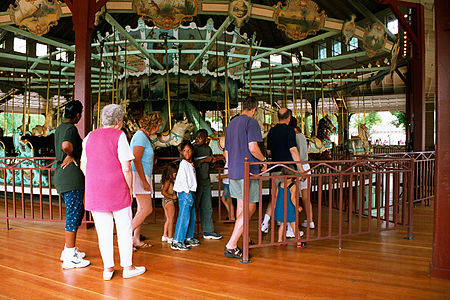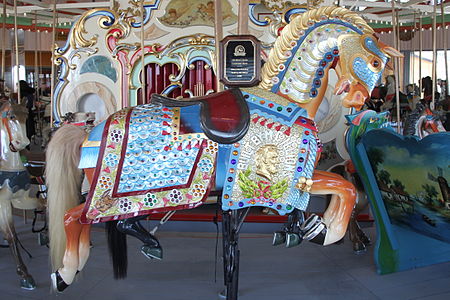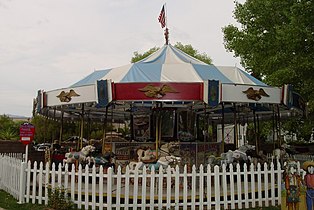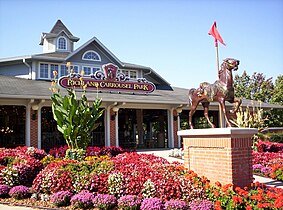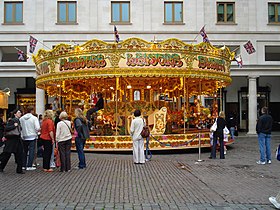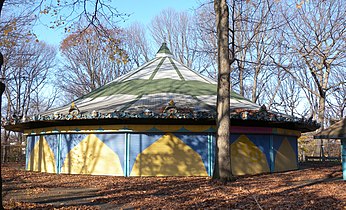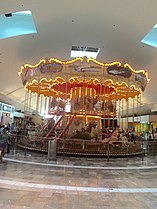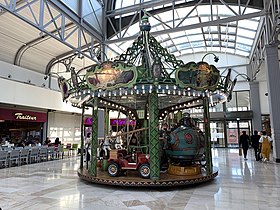Carousel

A carousel or carrousel (mainly North American English),[1] merry-go-round (international), Galloper (international) or roundabout (British English)[2] is a type of amusement ride consisting of a rotating circular platform with seats for riders. The "seats" are traditionally in the form of rows of wooden horses or other animals mounted on posts, many of which are moved up and down by gears to simulate galloping, to the accompaniment of looped circus music.
Carousels are commonly populated with horses, each horse weighing roughly 100 lbs (45 kg), but may include a variety of mounts,[3] for example pigs, zebras, tigers, or mythological creatures such as dragons or unicorns. Sometimes, chair-like or bench-like seats are used, and occasionally mounts can be shaped like aeroplanes or cars.
The names carousel and merry-go-round are also used, in varying dialects, to refer to a distinct piece of playground equipment.
History
[edit]Early carousels
[edit]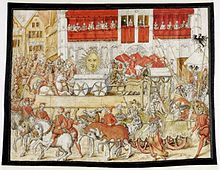
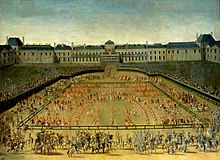
The modern carousel emerged from early jousting traditions in Europe and the Middle East. Knights would gallop in a circle while tossing balls from one to another; an activity that required great skill and horsemanship. [citation needed] This game was introduced to Europe at the time of the Crusades from earlier Byzantine and Arab traditions. The word carousel originated from the Italian Carosella and Spanish Carosella ("little battle", used by crusaders to describe a combat preparation exercise and game played by Turkish and Arabian horsemen in the 12th century).[4] This early device was essentially a cavalry training mechanism; it prepared and strengthened the riders for actual combat as they wielded their swords at the mock enemies.
By the 17th century, balls were no longer used, and instead, the riders had to spear small rings that were hanging from poles overhead and rip them off. Cavalry spectacles that replaced medieval jousting, such as the ring tilt, were popular in Italy and France. The game began to be played by commoners, and carousels soon sprung up at fairgrounds across Europe. At the Place du Carrousel in Paris, an early make-believe carousel was set up with wooden horses for the children.[5]
Another kind of carousel emerged in the 17th century in Belgium and France to celebrate special events. This was a ceremonial parade of knights and noblemen on horseback around a courtyard, accompanied by tournaments and various equestrian demonstrations and games, including the spearing of cardboard heads of "Moors" and "Saracens". The most famous carousel of this kind was held by Louis XIV in June 1662, in the courtyard of the Tuileries Palace, to celebrate the birth of his son and heir. The site of the event, next to the Louvre, is still known as "the Carrousel".[6]
By the early 18th century carousels were being built and operated at various fairs and gatherings in central Europe and England. Animals and mechanisms would be crafted during the winter months and the family and workers would go touring in their wagon train through the region, operating their large menagerie carousel at various venues. Makers included Heyn in Germany and Bayol in France. These early carousels had no platforms; the animals would hang from chains and fly out from the centrifugal force of the spinning mechanism. They were often powered by animals walking in a circle or people pulling a rope or cranking.
By 1803 John Joseph Merlin had a carousel in his Mechanical Museum in London, where gentry and nobility liked to gather on winter evenings. The horses "floated free over a pole". It was connected to a "big musical instrument that played a fully orchestrated concerto" and from the first note, the carousel would start turning while each horse would make a galloping movement with a visitor riding on its back. Merlin did not patent his inventions and engineers were allowed to come to create their own models of his creations.[7]
Direction of rotation
[edit]Viewed from above, and from the riders' point of view, in the United Kingdom, merry-go-rounds, called "gallopers" by the showmen community when populated by model horses, usually turn from the left to the right or clockwise (from the outside, or from the spectators' point of view, animals face to the left and the carousel apparently turns from the right to the left, the spectators' sense of clockwise ), while in North America and Mainland Europe, carousels typically go counterclockwise, that is, from right to left (from the spectators' point of view, animals face to the right and the carousel is seen as turning from left to right, the spectators' sense of counterclockwise).[8]
Modern carousels
[edit]By the mid-19th century, the platform carousel was developed; the animals and chariots were fixed to a circular floor that would suspend from a centre pole and rotate around. These carousels were called dobbies and were operated manually by the operator or by ponies.
In mid-19th-century England, the carousel became a popular fixture at fairs. The first steam-powered mechanical roundabout, invented by Thomas Bradshaw, appeared at the Pot Market fair in Bolton in about 1861. It was described by a Halifax Courier journalist as "a roundabout of huge proportions, driven by a steam engine which whirled around with such impetuosity, that the wonder is the daring riders are not shot off like cannonball, and driven half into the middle of next month."[9]
Soon afterwards, English engineer Frederick Savage began to branch out of agricultural machinery production into the construction of fairground machines, swiftly becoming the chief innovator in the field. Savage's fairground machinery was exported all over the world.[10] By 1870, he was manufacturing carousels with Velocipedes (an early type of bicycle) and he soon began experimenting with other possibilities, including a roundabout with boats that would pitch and roll on cranks with a circular motion, a ride he called 'Sea-on-Land'.[11]
Savage applied a similar innovation to the more traditional mount of the horse; he installed gears and offset cranks on the platform carousels, thus giving the animals their well-known up-and-down motion as they travelled around the centre pole – the galloping horse.[10] The platform served as a position guide for the bottom of the pole and as a place for people to walk or other stationary animals or chariots to be placed. He called this ride the 'Platform Gallopers'. He also developed the 'platform-slide' which allowed the mounts to swing out concentrically as the carousel built up speed. Fairground organs (band organs) were often present (if not built-in) when these machines operated. Eventually electric motors were installed and electric lights added, giving the carousel its classic look.
These mechanical innovations came at a crucial time, when increased prosperity meant that more people had time for leisure and spare money to spend on entertainment. It was in this historical context that the modern fairground ride was born, with Savage supplying this new market demand. In his 1902 Catalogue for Roundabouts he claimed to have "... patented and placed upon the market all the principal novelties that have delighted the many thousands of pleasure seekers at home and abroad."[12]
In the United States, the carousel industry was developed by immigrants, notably Gustav Dentzel of Germany and Charles W.F. Dare from England, from the late 19th century. Several centres and styles for the construction of carousels emerged in the United States:
- Coney Island style – characterized by elaborate and sometimes faux-jeweled saddles,[13] as well as mirrors to catch and reflect lights.[14] This style was pioneered by Charles I. D. Looff.
- Philadelphia style – known for more realistically painted saddles, this style was pioneered by Dentzel and the Philadelphia Toboggan Company.[15]
- Country Fair style – often with no saddles at all, this style was pioneered Allan Herschell and Edward Spillman of western New York, and Charles W. Parker of Kansas.
The golden age of the carousel in America was the early 20th century,[citation needed] with large machines and elaborate animals, chariots, and decorations being built.
-
Pictured in Margate, England in the 1880s, Savage's amusement ride, Sea-On-Land, where the riders would pitch up and down as if they were on the sea. His "galloping horse" innovation is seen on carousels today.
-
Carousel built in 1905 by Gustav Dentzel which is still operational in Rochester, New York
-
A 1909 horse by Marcus Illions in the Coney Island style
-
1900 horse by Salvatore Cernigliaro for Dentzel in the Philadelphia style
-
Carousel horse by Allan Herschell Company in the Country Fair style
Antique and notable carousels
[edit]The National Carousel Association maintains a list of Historic Carousel Award winners, primarily focused on carousels in Canada and America.[16]
Pre-1869
[edit]| Name | Year | Location | Builder | Brass ring | Notes | Image | References |
|---|---|---|---|---|---|---|---|
| Vermolen Molen | 1865 | Kaatsheuvel, Netherlands | The oldest operational carousel in the world, Vermolenmolen.
The 'Vermolen Boden Carousel' in the Efteling dates back to 1865. It was originally turned by horses. At present it is turned by an electric motor. |
[17] | |||
| Hanau Carousel | 1780 | Wilhelmsbad, Hanau | The oldest stationary carousel in the world. It was built in 1780 in Hanau and has four chariots and twelve horses. The horses and coaches date from 1896. In 1970, twelve of the 16 wooden horses were stolen. | [18][19] |
1870–1879
[edit]| Name | Year | Location | Builder | Brass ring | Notes | Image | References |
|---|---|---|---|---|---|---|---|
| Charles Looff Carroussel | 1875 | Coney Island, New York | Looff | First carousel and amusement ride at Coney Island. Installed at Mrs. Lucy Vanderveer's Bathing Pavilion in 1876. It was probably burned during the devastating fire on Coney Island in 1911.[20] | 
|
[citation needed] | |
| Flying Horses Carousel | 1876 | Oak Bluffs, Massachusetts | Charles Dare | The nation's oldest platform carousel has been designated by the U.S. Department of the Interior as a national landmark. Constructed in 1876 by Charles Dare, it is one of only two Dare carousels still in existence. Originally operated at a Coney Island, NY amusement park, it was moved to Oak Bluffs in 1884, where it has lived in its red barn, delighting generations of Island residents and visitors ever since. The carousel was acquired by the Martha's Vineyard Preservation Trust in 1986 to prevent it from being dismantled and sold piecemeal to collectors of antique carved horses. | 
|
[citation needed] | |
| Flying Horse Carousel | 1876 | Watch Hill, Westerly, Rhode Island | Charles Dare | Built in 1876 and listed as a National Historic Landmark. It is one of two Charles Dare carousels in existence. It is considered the oldest of its type "in which the horses are suspended from a center frame," as opposed to being mounted on a wooden platform, which causes the horses to "fly" as the carousel gains speed. | [21] | ||
| Melbourne Zoo Carousel | 1878 | Royal Melbourne Zoological Gardens, Melbourne, Victoria, Australia | Built in 1878 in England and imported to Australia in the 1880s by John Briggs. The carousel traveled the show circuit until 1963, when it finally arrived at Melbourne Zoo. Restoration completed 2005. | [22][23] |
1880–1889
[edit]| Name | Year | Location | Builder | Brass ring | Notes | Image | References |
|---|---|---|---|---|---|---|---|
| Le Galopant | 1885 | La Ronde, Montreal | The oldest galloping carousel in the world. Built in 1885 in Bressoux by Belgian craftsmen, it stayed there until 1964, when it was moved to the 1964 New York World's Fair. For Expo 67 it came to Montreal as part of the rides featured in La Ronde. In 2003, the Carousel underwent a meticulous restoration under the current park ownership, Six Flags. More than $1 million was spent to refurbish the ride, which reopened in a new specially landscaped garden in 2007. The carousel was retired from operation in 2019, however still remains on site and slowly deteriorating. | 
|
[24][25] |
1890–1899
[edit]| Name | Year | Location | Builder | Brass ring | Notes | Image | References |
|---|---|---|---|---|---|---|---|
| Gallopers, Hobart, Tasmania | c. 1890 or earlier (other sources say 1885 or 1882) | Hobart, Tasmania | Howcrofts of Hartlepool / Savage's of Kings Lynn (conversion) | Originally constructed with "leaping hounds" by Howcrofts of Hartlepool and operated for 40 years around the north of England by the showman family of Emerson & Hazard; hounds replaced with horses and cockerels by Savage's of Kings Lynn, Norfolk, prior to 1920; subsequently at Dreamland, Margate, UK, circa 1940s-1980. Purchased in 1990 by Mark Money of Kingston, Tasmania and subsequently restored to full working order, with what is stated to be the original steam engine operating it, and operated around Tasmania, including the Hobart waterfront and the Royal Tasmanian Botanical Gardens, circa 2009-2013. This photograph taken in 2013; the ride was offered for sale in 2016 but whether or not it was sold at that time is not presently known. See also additional notes accompanying this image, https://commons.wikimedia.org/wiki/File:Gallopers-Tasmania-2013-01.jpg | 
|
[26][27][28] | |
| Letná Carousel | 1892 | Letná Park, Prague | The oldest preserved carousel in Europe. Has been renovated recently (2022). The carousel is still located in the original wooden pavilion and the interior is furnished in its almost original form from 1892. It features 21 horses covered with real horse skin and four cars. | 
|
[29] | ||
| Darling Harbor Carousel | c.1890s | Tumbalong Park, Darling Harbour, Sydney | A New South Wales Heritage listed attraction. It is an example of an old Edwardian Carousel which are very rare nowadays. It is operated by a classic steam engine which has been retained. The Carousel dates back to the 'Golden Age' of Carousels between the 1890s to the 1920s. First imported to Australia in 1894. | 
|
[30] | ||
| The Flotilla | c.1894 | High Park, CNE grounds, Munro Park | O. L. Hicks | Miniature boats (replicas of Columbus' ships) travelled in a circular trough. Chains pulled the boats. | 
|
[31][32] | |
| Stoomcarrousel | c.1895–1903 | Efteling. Kaatsheuvel. Brabant. The Netherlands | Hendrik Janvier | This carousel was built between 1895 and 1903 by designer Hendrik Janvier (1868–1932). Janvier was the progenitor of the famous Dutch funfair family Janvier and is seen as the founder of the Stoormcarrousel tradition. He used tools from different manufacturers, because there did not yet exist a dedicated stoomcarrousel manufacturer yet. Upgrades and renovations were made in the years after 1903.
Today this old stoomcarrousel is located in the Efteling (Themepark). In 1955 the Efteling bought the ride for ƒ 15.475,-. (Gulden) from the Janvier family. It reopened in 1956. Originally, the price for a ticket to make a ride, was only 5 cents. Before the purchase by the Efteling, the Stoomcarrousel was named is 'Stoomcaroussel' . (1 r & 2 s') Contains: 22 Horses, 4 Coaching's, 2 Pigs & 2 clowns. Music played by: 1 Gavioli organ Engine: Fam. König, Swalmen, |

|
None | |
| Steam Gallopers | 1895 | Carters Steam Fair (traveling) | Robert Tidman & Sons of Norwich | Run on steam to this day | 
|
[33] | |
| Crescent Park Looff Carousel | 1895 | Crescent Park, East Providence, Rhode Island | Looff | Still operates in its original location. The 61 horses, one camel, and four chariots have been restored and the ride renovated. Charles I. D. Looff used this carousel as a showpiece for prospective customers. This is one of the few carousels that feature a ring-arm with steel rings and a brass ring. The original A. Ruth & Sohn organ still plays music for the patrons. | 
|
[citation needed] |
1900–1909
[edit]| Name | Year | Location | Builder | Brass ring | Notes | Image | References |
|---|---|---|---|---|---|---|---|
| Forest Park Carousel | 1903 | Woodhaven section of the New York City borough of Queens | Muller Brothers | One of only two surviving Muller brothers carousels, it was listed on the National Register of Historic Places in 2004. | [34][35] | ||
| Dentzel Menagerie Carousel | 1905 | Ontario Beach Park in Rochester, New York | Dentzel | Still in operation, the historic Dentzel Menagerie Carousel is one of only fourteen operating antique menagerie carousels in the United States. | 
|
[36] | |
| Lakeside Park Carousel | 1905 | Historic Lakeside Park in Port Dalhousie, Ontario, Canada | Looff/Kremer | Brought to St. Catharines in 1921. It continues to provide amusement for young and old alike, at just 5 cents a ride. | 
|
[37] | |
| Children's Creativity Museum Carousel | 1906 | Children's Creativity Museum in Yerba Buena Gardens, San Francisco | Looff | Sent to Seattle after the 1906 earthquake and returned to serve at Playland-at-the-Beach until that park's demise in 1972. | [38] | ||
| Centreville Carousel | 1907 | Centreville Amusement Park, Toronto Islands, Toronto, Ontario, Canada | Dentzel Carousel Company | Acquired from Bushkill Park in Easton, Pennsylvania in 1966. Although it was sold to Carmel, Indiana in mid-2017, the deal was not approved by Carmel city council and the carousel currently remains in Toronto. | 
|
[39][40] | |
| Carousel El Dorado | 1907 | Toshimaen in Tokyo, Japan (1971-current) Steeplechase Park in New York (1911–1964) |
Hugo Haase | Mechanical Engineering Heritage (Japan) No.38 | 
|
[41] | |
| Heritage Carousel | 1908 | Heritage Museums and Gardens in Sandwich, Massachusetts | Looff | Electrically powered. Originally built for a park in Meridian, Mississippi; acquired by Josiah K. Lilly III in 1968 and reassembled at Heritage Museums & Gardens in 1972. | 
|
[42] | |
| Riverfront Park Carousel | 1909 | Riverfront Park in Spokane, Washington | Looff | Originally installed at the Natatorium Park in Spokane. | 
|
[43] | |
| Albany Carousel and Museum | 1909 | Downtown Albany, Oregon | Dentzel | Dentzel Menagerie Carousel completely rebuilt in the downtown area of Albany, Oregon, completion date set for June 2017. The carousel is housed in a state of the art 22,000-square-foot facility which includes a complete artist studio for the creation of additional animals. Construction used old growth timber that was completely re-manufactured from the previous building that housed the carving studio circa 1920. | 
|
[44] |
1910–1919
[edit]| Name | Year | Location | Builder | Brass ring | Notes | Image | References |
|---|---|---|---|---|---|---|---|
| Balboa Park Carousel | 1910 | Balboa Park, San Diego, California | Herschell-Spillman | Initially shipped to Los Angeles and arrived in the San Diego area in 1915. In Balboa Park since 1922. | 
|
[45] | |
| Santa Cruz Looff Carousel | 1911 | Santa Cruz Beach Boardwalk, Santa Cruz, California | Looff | One of the few carousels still in its original location for more than 100 years. It is a "pure carousel" meaning all of the horses were provided by the same company that built the carousel. It is also one of the few with the rare combination of a working ring dispenser and outside row jumping horses. The carousel features three band organs including a rare Ruth & Sohn 96-key organ with 342 pipes. The Looff carousel was designated a national historic landmark in 1987. | 
|
[46] | |
| Tilden Park Merry-Go-Round | 1911 | Tilden Park in Berkeley, California | Herschell-Spillman | Built in 1911 by the Herschell-Spillman Company and is one of the few carousels from its day still in operation. In 1976 it was listed on the National Register of Historic Places. | 
|
[47][48] | |
| Pullen Park Carousel | 1912 | Pullen Park, Raleigh, North Carolina | Dentzel | 52 wooden animals carved by Salvatore Cernigliaro. Added to National Register of Historic Places in 1976. | 
|
[49] | |
| Merry-Go-Round Steam Gallopers | 1912 | Hollycombe Steam Collection (traveling) | Tidman of Norwich | A working steam driven Merry-Go-Round with 3-abreast Steam Gallopers. It has 24 horses, six cockerels and two chariots (for those who don't relish the galloping motion). It is driven by a steam centre engine, also Tidman, and has revolving pillars, which are believed to be the only ones still operating. Musical accompaniment is driven by a slotted card Tidman organ engine. | 
|
[50] | |
| Nunley's Carousel | 1912 | Cradle of Aviation Museum, Garden City, New York | Stein and Goldstein Artistic Carousel Co. | Operated at Nunley's Amusement Park, Baldwin, N.Y. until that park's closure in 1995. Subsequently, purchased by Nassau County and placed in storage. It was fully restored and opened in 2009 at the Cradle of Aviation Museum in Garden City, N.Y. | 
|
[51] | |
| Cafesjian's Carousel | 1914 | Como Park, Saint Paul, Minnesota | A mainstay at the Minnesota State Fair from 1914 to 1988, when it was saved from the auction block by a non-profit group organized to save the landmark. The carousel is now located in Como Park in Saint Paul, Minnesota. | [52] | |||
| Grand Ole Carousel | 1915 | Six Flags St. Louis, Eureka, Missouri | Philadelphia Toboggan Company #35 | Built by Philadelphia Toboggan Company in 1915 for Cleveland's Luna Park. Relocated to Puritas Springs, Cleveland, from 1930 to 1958 then Indian Lake Park, Russell's Point, Ohio, 1959 to 1971. Acquired by Six Flags St. Louis in 1972 where it opened in the park's England themed section (now Britannia) as "Carousel." It was renamed "Grand Ole Carousel" in 1984, then "Enchanted Carousel" in 1995. In 1998, its name reverted to "Grand Ole Carousel." | 
|
[53] | |
| Santa Monica Looff Hippodrome | 1916 | Santa Monica Pier, Santa Monica, California | Philadelphia Toboggan Company | Housed a carousel by Looff until it was sold in 1939. It was replaced by Philadelphia Toboggan Company Carousel No. 62, which was moved from the Ocean Park Pier. Since 1977, the carousel has been owned by the city. The building remains a rare example of structures that used to be on the amusement pier. It was restored from 1977 through 1981. It was declared a National Historic Landmark in 1987. | 
|
[54][55] | |
| Herschell Carrousel Factory Museum | 1916 | Herschell Carrousel Factory Museum, North Tonawanda, NY | Herschell-Spillman | Features two working carousels: The largest is a 1916 model that is 40 feet (12.2 m) in diameter, with 36 hand-carved horses and over 580 lights. The second is a small aluminum carousel specifically designed for children. The museum is located in the building complex which housed the Allan Herschell Company and is the only museum in the world housed inside an authentic carousel factory. | 
|
[56] | |
| Riverside Park
Carousel |
1919 | Riverside Park Antique Carousel, Guelph, Ontario, Canada | Allan Herschell Company | Originally built in 1919, the 3 row, 28 jumper, 2 menagerie animals & 4 chariot carousel was bought by the City of Guelph from Conklin Garrett (Brantford) in 1970 for $6000 and erected here. It remained in operation in 1976 when it was closed for three years due to disrepair. In 1979 it reopened after a campaign in 1976 ensued to save the carousel. For years, the carousel was dismantled before the winter months until 1999 when a permanent structure was built. | Picture | [57] [58] |
1920–1929
[edit]| Name | Year | Location | Builder | Brass ring | Notes | Image | References |
|---|---|---|---|---|---|---|---|
| Grand Carousel | 1926 | Kennywood Park, West Mifflin, Pennsylvania | Dentzel | A National Historic Landmark. The music on this carousel is provided by a 1916 Wurlitzer Style No. 153 Military Band Organ and over 1500 lights decorate this ride. The carousel features 50 jumping and 14 stationary horses, a magnificent lion and tiger, and Dentzel's signature Jesters and Cherubs. | 
|
[59] | |
| Grand Carousel | 1926 | Kings Island, Cincinnati, Ohio | Philadelphia Toboggan Company | Built in 1926 for Cincinnati's Coney Island, PTC No. 79 stands 80 feet wide and features 48 horses and two chariots. The carousel is adorned with 37 oil paintings depicting scenes from all over the world, 20,000 sheets of 23-karat gold leaf, 1,000 sheets of sterling silver, over 700 lights and hundreds of mirror accents. Music is proved by a Wurlitzer Duplex Orchestral Organ (#157). The carousel operated for 45 years at Coney Island and was relocated to Kings Island in 1972. | [60] | ||
| Antique Carousel | 1928 | Canada's Wonderland in Toronto, Ontario | Philadelphia Toboggan Company | Originally located in Palisades Park, New Jersey the carousel was also used at Happyland Park or Hastings Park, Vancouver, British Columbia, and Palace Playland, Old Orchard Beach, Maine, before it was purchased by Taft Broadcasting in the 1970s and put into storage. It opened in its current location in 1981. | 
|
[61][62] | |
| Holyoke Merry-Go-Round | 1929 | Heritage State Park in Holyoke, Massachusetts | Philadelphia Toboggan Company | Originally assembled at the now shuttered Mountain Park. The carousel was reassembled and preserved (in full operation) at Heritage State Park with the help of John Hickey and the Holyoke Water Power Company in 1993. | 
|
[63] |
1930–1939
[edit]- The King Arthur Carrousel has existed since 1922 and was moved to Disneyland in 1954. It is an assembly of two carousels. Walt Disney wanted it to have four courses of all jumpers. The remaining chariot woodwork was repurposed as the "Calliope" tenders of Casey Jr. Circus Train powered gravity coaster.[64]
1940–1949
[edit]- The carousel at Harper Motors is an iconic landmark on the North Coast of California. It was bought by the dealerships owner Harvey Harper in 1991, after purchase this 1947 Allan Herschell Carousel was shipped to Oakland by train and drive to Eureka in a semi-truck. It took a year to assemble on site. It was refurbished and repainted in 2013 which caused the ride to be closed for a month. It is open daily free of charge to the public from 12–4 except on holidays and when inclement weather doesn't allow for riders.[65]

Carousel in Bobbejaanland, Belgium
Unique and record breaking
[edit]- The carousel at Phantasialand in Germany is one of the biggest in the world, made by Preston & Barbieri one historical amusement ride factory in Italy.[66]
- The world's only two-row stationary carousel built from an original Dentzel blueprint left in existence,[67] the Highland Park Dentzel Carousel and Shelter Building, is located in Highland Park in Meridian, Mississippi.
- In May 2005, William Henry Dentzel III, built the world's first solar-powered carousel. The carousel operates during Solfest at the Solar Living Institute in Hopland, California.[68][69]
- There is only one carousel in the world that rides in a waving motion – "Over the Jumps: The Arkansas Carousel" in Little Rock, Arkansas. It is also the only remaining wooden track carousel built by the Herschell & Spillman Company, and one of only four track carousels still in existence.[citation needed]
- The carousel at Conneaut Lake Park in Conneaut Lake, Pennsylvania is the last T.M. Harton Carousel that is still in operation and its Artizan band organ is one of two known of the same model in the world.[citation needed]
- In 2007, SeaWorld Orlando opened Sea Carousel, Florida's first aquatic carousel.[citation needed]
- In 2012, Buttonwood Park Zoo opened an Americana carousel by Chance Rides.
- In 2013, Palm Beach International Equestrian Center opened a Bertazzon Venetian Carousel as part of the Winter Equestrian Festival (the first carousel to be used in events besides South Florida Fair and the first Palm Beach County carousel built by Bertazzon)
- Binghamton, New York is considered the "Carousel Capital of the World" for the six original carousels in the Triple Cities area, donated by George F. Johnson, owner of the Endicott-Johnson Company early in the 20th century. These carousels, manufactured by the Allen Hershell Company in the "country fair" style, were donated with the express stipulation that they would never charge admission for anyone to ride them. Apparently when Mr. Johnson was a child he was frequently too poor to ride the local carousel and he vowed this would never happen to another child in the area. The carousel at the Ross park zoo in Binghamton, NY does charge admission, in a way, as it requires the child to drop one piece of litter found in the park into a trash barrel in order to ride. This is all written on a plaque at the entrance to the carousel.[70]
- The two double-decker Columbia Carousels built by Chance Rides and located at Six Flags Great America and California's Great America are the two tallest carousels in the world.[71]
- The Merry-Go-Round at Bear Mountain State Park in New York, features hand-painted scenes of the Park and 42 hand-carved seats of native animals including a black bear, a wild turkey, a deer, a raccoon, a skunk, a Canada goose, a fox, a swan, a bobcat, a rabbit, and more.[72]
- On Canada Day 2016, a new attraction was opened in Downtown Markham, Ontario. The Pride of Canada Carousel was commissioned by Christopher Bratty, current president of the real estate and development firm The Remington Group.[73] The carousel was produced and originally envisioned by Shelley M. Shier of Broadway Bound Fine Arts and Entertainment for The Remington Group.[74] The carousel sits inside a glass pavillon designed by Sheldon Levitt from Quardrangle Architects.[75] The carousel itself features 44 ride-able reusable material sculptures representing different elements of Canadian culture. It was designed by artist Patrick Amiot who worked with the Brass Ring Carousel Company to build the ride.[76]
- Ice floe carousels have been constructed on frozen lakes.[77] For example, in 2017 an ice carousel was made in Finland. It was constructed by cutting the ice in a circle with a chainsaw.[78]

In popular culture
[edit]- In Mary Poppins, Mary, Bert, and the children ride a merry-go-round, then leave the carousel on their horses to go off on a fox hunt and a horse race.
- In the film Charade, near the end, there is a scene where appears a carousel in the background with the music of the main theme, a Parisian waltz composed by Henry Mancini (Charade carousel) played with bells.
- In the film Logan's Run, the residents of a domed city of the future are doomed to die on their 30th birthday, unless they can be "renewed" in a ritual known as "carousel".
- In Something Wicked This Way Comes by Ray Bradbury, the carnival's steam carousel can cause riders to become younger or older depending on the direction, left and right in which they ride.
- Carousel (1945) was a Broadway musical featuring hit songs such as "If I Loved You" and "You'll Never Walk Alone". The protagonist, Billy Bigelow, is a carousel barker.
- In the dramatic climax scene of Alfred Hitchcock's Strangers on a Train (1951) the hero and the villain struggle on a carousel.
- David Carradine's 1983 film Americana revolves around a Vietnam veteran's obsession with the restoration of an abandoned carousel.
- In the Australian children's picture book The Carousel by Ursula Dubosarsky, illustrated by Walter di Qual, after an exhilarating ride on a carousel, a child has a semi-mystical vision of the carousel horses breaking free from the wheel and galloping across the world.[79]
- The children's television programme The Magic Roundabout uses a carousel as its central motif.
- The film The Sting features a large indoor carrousel adjacent a brothel, where the Madame allows the girls to ride on slow nights.
- The three installments of the book series Kingdom Keepers: The Return[80] by Ridley Pearson[81] features the carousel from Disneyland being used as a time machine to the opening of Disneyland Park.
- The carousel at House on the Rock is billed as the world's largest indoor carousel.
- In the 2012 music video for Gangnam Style, a carousel in the Gangnam district is used as one of the backdrops while Psy dances.
- In 2014, American singer-songwriter, Melanie Martinez, released a song "Carousel", using carousel as a metaphor for love which goes in circles endlessly.[82]
- The children's television programme Playdays had a roundabout called Rosie who was the focus of episodes broadcast on Wednesdays from 1992 to 1997, maintained by Mr. Jolly.
Gallery
[edit]-
Modern carousel in Brussels.
-
James Noyce & Sons' traditional "gallopers" at Nottingham Goose Fair in 1983.
-
A 1920s C.W. Parker merry-go-round in Tucson, Arizona.
-
Town Square Carrousel at Adventureland in Altoona, Iowa (Chance-Morgan). Also has a decorative crown for a top.
-
Mangels-Illions Carousel, after its 2000 restoration, on the grounds of the Columbus Zoo and Aquarium in Columbus, Ohio.
-
Richland Carrousel Park in Mansfield, Ohio is the first hand-carved indoor wooden carousel to be built and operated in the United States since the early 1930s.
-
A traditional Merry-go-round in Covent Garden, London, August 2007.
-
William F. Mangels Kiddie Galloping Horse Carrousel, c. 1935.
-
Kennywood's Merry-Go-Round built by William H. Dentzel in 1926 for the World's Fair.
-
Forest Park Carousel all closed for the season, November 2009.
-
A small hand-driven carousel in Portosín, Porto do Son.
-
Central Park Carousel at Central Park in New York City.
-
Former Venetian Carousel at Garden State Plaza in Paramus, New Jersey, which closed in 2016.
-
Former Philadelphia Toboggan Company Carousel Number 15 at the Palisades Center in West Nyack, New York before it was removed and replaced by a Venetian Carousel in 2009.
-
MOS Plaza Merry-go-round
-
"Jules Verne" carousel with steampunk style near Paris.
-
Wooden horses on a carousel in Maryland, USA.
See also
[edit]- C. W. Parker Carousel
- Carousel of Progress—a theatre that revolves a seated audience around central stages
- Chair-O-Planes, aka a swing carousel
- Charles I. D. Looff
- Crescent Park Looff Carousel
- Herschell Carrousel Factory Museum
- Philadelphia Toboggan Company
References
[edit]- ^ From French carrousel or Italian carosello, originally meaning a tilting match. In American English it may also be referred to as a galloper, a jumper, a horseabout, a horse tornado, or flying horses.[citation needed]
- ^ Oxford English Dictionary. Also sometimes called a roundabout (Chambers Dictionary), but this more usually refers to a piece of playground equipment.
- ^ "A Brief History of the Carousel". International Museum of Carousel Art. Archived from the original on 4 March 2017. Retrieved 24 July 2008.
- ^ "A Brief History of the Carousel". Archived from the original on 4 March 2017. Retrieved 24 July 2008.
- ^ "Merry-go-rounds". 27 January 2021.
- ^ Jacquin, Emmanuel, "Les Tuileries Du Louvre a la Concorde", (2000), pp. 14-15
- ^ Goede, Christian August Gottlieb (10 April 1804). "England, Wales, Irland und Schottland: Erinnerungen an Natur und Kunst aus einer Reise in den Jahren 1802 und 1803". Arnold – via Google Books.
- ^ "Introduction To Carousel Art: American Antiques | American folk art | carousel horse". www.americanaantiques.net.
- ^ "Fairground Rides – A Chronological Development". University of Sheffield. Archived from the original on 11 August 2011.
- ^ a b "Frederick Savage, Victorian fairground manufacturer of King's Lynn". Norfolk.gov.uk. Retrieved 25 February 2018
- ^ McMonigle, Ken. "Swings and Roundabouts".
- ^ "Frederick Savage, Victorian Fairground Manufacturer of King's Lynn". Archived from the original on 13 December 2013. Retrieved 7 December 2013.
- ^ Antiques Roadshow, Spokane, Washington, broadcast 4 August 2007.
- ^ Morgan, Brian (2001). "Major Carousel Builders and Carvers (Page 1 of 3) - The Coney Island Style". Carousels.org. National Carousel Association. Retrieved 21 January 2023.
- ^ Morgan, Brian (2001). "Major Carousel Builders and Carvers (Page 2 of 3) - Philadelphia Style". Carousels.org. National Carousel Association. Retrieved 21 January 2023.
- ^ "Carousels with Awards and Special Features". National Carousel Association. Retrieved 25 September 2017.
- ^ "Group honoured for saving world's oldest stationary carousel". guinnessworldrecords.com. 2001.
- ^ "Group honoured for saving world's oldest stationary carousel". Thelocal.de. 11 November 2010.
- ^ "Hanau Carousel, Hanau-Wilhelmsbad State Park". Carousels.org. Retrieved 22 December 2019.
- ^ "On 100th anniversary, Coney Island remembers Dreamland Park fire". New York Post. 27 May 2011.
- ^ "National Historic Landmarks Program (NHL)". Tps.cr.nps.gov. 27 February 1987. Archived from the original on 23 November 2010. Retrieved 26 June 2014.
- ^ "Zoo carousel, 1970s". Culture Victoria. Retrieved 17 March 2019.
- ^ "VHD". vhd.heritagecouncil.vic.gov.au.
- ^ "EXPO 67: THEN AND NOW – Tourisme Montréal Blog". 9 May 2012. Retrieved 11 August 2016.
- ^ Hustak, Alan (4 May 2007). "Spirit of Drapeau makes appearance to launch La Ronde's 40th season". The Gazette.
- ^ "Emerson & Hazard's Amusement Caterers". Retrieved 14 May 2022.
- ^ "National Fairground and Circus Archives search ("Emerson Hazard Gallopers")". University of Sheffield. Retrieved 14 May 2022.
- ^ "Passion makes magic go round". Daily Telegraph (Australia).
- ^ "V Praze stojí nejstarší dochovaný kolotoč v Evropě". Radio Prague International (in Czech).
- ^ "Darling Harbour Carousel and Band Organ". Property New South Wales. Retrieved 24 September 2017.
- ^ "The Ronald Engine Accepted". Toronto Globe. Toronto. 25 April 1895. p. 2.
- ^ "The Pleasure of Summer". Toronto Globe. Toronto. 24 May 1899. p. 4.
- ^ "Carters Steam Fair :: Jubilee Steam Gallopers". www.visit.carters-steamfair.co.uk. Archived from the original on 6 April 2015. Retrieved 7 December 2015.
- ^ LaFrank, Kathleen (January 2004). "National Register of Historic Places Registration: Forest Park Carousel". New York State Office of Parks, Recreation and Historic Preservation. Archived from the original on 21 March 2012. Retrieved 16 January 2011. See also: "Accompanying 35 photos". Archived from the original on 21 March 2012. Retrieved 18 January 2011.
- ^ "National Register Information System". National Register of Historic Places. National Park Service. 13 March 2009.
- ^ "Dentzel Menagerie Carousel". cityofrochester.gov. Retrieved 17 July 2016.
- ^ "Lakeside Park Carousel – St. Catharines". Stcatharines.ca. Retrieved 26 June 2014.
- ^ Hartlaub, Peter (12 July 2009). "Bay Area clinging on its classic carousels". San Francisco Chronicle. Retrieved 19 July 2017.
- ^ Lee-Shanok, Philip (10 September 2017). "'Carouselgate' could mean Centreville carousel won't be leaving, at least for now". CBC News. Retrieved 25 September 2017.
- ^ "From fireworks to festivals: What to do in Toronto this long weekend". CBC News. 18 May 2018. Retrieved 17 March 2019.
- ^ 機械遺産カルーセルエルドラド (in Japanese) Toshimaen
- ^ "1908 Looff Carousel". Heritage museums & gardens. Archived from the original on 25 September 2017. Retrieved 25 September 2017.
- ^ "SpokaneCarrousel.org".
- ^ "Albany Carousel".
- ^ "Balboa Park Carousel". Balboa Park. Retrieved 24 September 2017.
- ^ Seifert, Jeffrey (November 2011), "Santa Cruz Beach Boardwalk's Looff Carousel celebrates 100 years", Amusement Today, 15 (8.2): 1–7
- ^ "National Register of Historic Places in Contra Costa County". Retrieved 3 January 2013.
- ^ "Census of Classic Wood Carousels". National Carousel Association. Retrieved 3 January 2013.
- ^ Currie, Virginia; Turner, Ann; Cockshutt, Catherine (April 1976). "Pullen Park Carousel" (PDF). National Register of Historic Places – Nomination and Inventory. North Carolina State Historic Preservation Office. Retrieved 1 May 2015.
- ^ "Golden Gallopers". www.hollycombe.co.uk.
- ^ "Historic Nunley's Carousel at Museum Row". cradleofaviation.org. Archived from the original on 28 December 2012. Retrieved 3 January 2013.
- ^ "Cafesjians Carousel—Welcome".
- ^ "Grand Ole Carousel". Six Flags St. Louis. Retrieved 16 December 2018.
- ^ Carousel History page that is no longer available at santamonicapier.org, but is archived at archive.org.
- ^ Charleton, James H. (2 November 1984). "National Register of Historic Places Inventory-Nomination: Looff's Hippodrome / Santa Monica Amusement Pier Carousel Building" (pdf). National Park Service. and Accompanying 1 photo, from 1985. (397 KB)
- ^ "The Museum's Exhibits". Archived from the original on 23 February 2012. Retrieved 23 February 2012.
- ^ "Carousel Mural". City of Guelph. Retrieved 15 June 2024.
- ^ "Riverside Park Carousel - Carousels on Waymarking.com". www.waymarking.com. Retrieved 15 June 2024.
- ^ Jacques, Charles Jr. (1982). Kennywood...Roller Coaster Capital of the World. Vestal, New York: The Vestal Press Ltd. pp. 174–177. ISBN 0-911572-24-4.
- ^ Keeter, John (9 May 2017). "What Goes Around..." Kings Island. Retrieved 12 October 2018.
- ^ "Antique Carousel | Canada's Wonderland". www.canadaswonderland.com. Retrieved 10 August 2016.
- ^ "CWMania • Ride Info – Antique Carrousel". www.cwmania.com. Archived from the original on 12 August 2016. Retrieved 10 August 2016.
- ^ "Holyoke's Happiness Machine: The History of the Holyoke Merry-Go-Round". The Holyoke Merry-Go-Round. Retrieved 25 September 2017.
- ^ "Casey Jr. Circus Train".
- ^ "Another go-round: Harper family carousel closed for restoration". Retrieved 11 August 2016.
- ^ "Preston & Barbieri Amusement rides manufacturer". Preston & Barbieri.
- ^ Meridian.MS.org Archived 17 April 2008 at the Wayback Machine, Dentzel Carousel.
- ^ "California Carousel". Roadside Architecture.com. Archived from the original on 3 March 2016. Retrieved 3 January 2013.
- ^ "Gallery 2: Cloud Room". Dentzel.com. Retrieved 3 January 2013.
- ^ "City Carousels". City of Binghamton. Retrieved 9 September 2024.
- ^ Moschke, Will (2011). "35 Years at the Great America Parks". RollerCoaster! Magazine. 32 (4): 6. ISSN 0896-7261.
- ^ "Palisadesparksconservancy.org". Archived from the original on 1 May 2009.
- ^ Clarke, Katrina (July 2016). "Markham to open $10M scrap-metal carousel on Canada Day | Toronto Star". The Toronto Star. Retrieved 15 August 2016.
- ^ "Introducing the Pride of Canada Carousel, an ode to the country in the revitalized core of Markham | National Post". National Post. 13 July 2016.
- ^ "Pride of Canada Carousel Spins Up in Downtown Markham | Urban Toronto". urbantoronto.ca. Retrieved 15 August 2016.
- ^ "Pride of Canada Carousel – Carousel | Downtown Markham". www.downtownmarkham.ca. Retrieved 15 August 2016.
- ^ Chan, Casey (6 August 2015). "Crazy people chainsawed a frozen lake to make a spinning ice carousel". Gizmodo. Gawker Media. Retrieved 7 August 2015.
- ^ Romeo, Claudia. "A Finnish man made an ice carousel on a frozen lake using a chainsaw". Business Insider. Retrieved 28 August 2021.
- ^ "The Carousel – Penguin Books Australia". Archived from the original on 29 March 2012. Retrieved 3 July 2012.
- ^ "The Kingdom Keepers". thekingdomkeepers.com.
- ^ "Adventure Novels - Ridley Pearson". Archived from the original on 8 April 2018. Retrieved 2 July 2018.
- ^ Melanie Martinez – Carousel, retrieved 9 August 2022
External links
[edit]- The National Carousel Association Archived 23 January 2011 at the Wayback Machine
- The C. W. Parker Carousel Museum
- International Museum of Carousel Art
- Video of a hand-cranked carousel in Szentendre, Hungary
- Historic Carousels at the 1964–65 New York World's Fair
- The oldest carousel in the world


